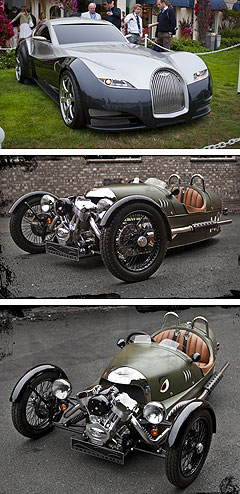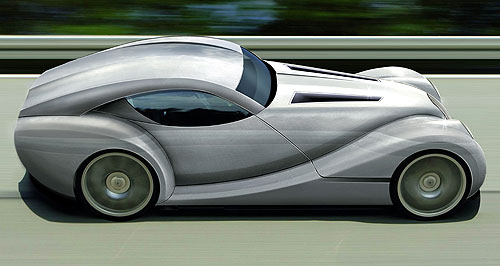Make / Model Search
Future models - Morgan - +EGeneva show: Morgan likely to unveil EV conceptsBritish green: The sleek Morgan LIFEcar2 concept is powered by a diesel-electric hybrid powertrain. Niche Brit brand Morgan announces Geneva presence as Aussie sales hit all-time high23 Jan 2012 AUSTRALIANS took delivery of a record 20 Morgan cars last year, the first time the traditionalist British brand has breached double-digit registrations Down Under, as it toils to get Australian Design Rule (ADR) approval for its born-again Three-Wheeler. The news comes as Morgan prepares to whip the covers off three “new exciting models and concepts” at the Geneva motor show in early March, which are more likely to be electric and hybrid-powered vehicles than the delayed EvaGT 2+2 coupe. Morgan is keeping details of its Geneva trio under wraps, but the sportscar builder has been working on two EVs dubbed ‘+E’ that see the usual 4.8-litre BMW V8 engine of the Aero Supersports replaced with a 70kW electric motor. The electric drivetrain is produced by British firm Zytek, which has provided drivetrain componentry and expertise for the development of electric city-cars including the first-generation Smart Electric Drive and Gordon Murray’s T.27. Morgan’s EV duo will ride on a hand-made bonded and riveted aluminium chassis, to which the lithium-ion battery packs will be mounted. The third car could be a hybrid, for in August 2010 Morgan announced it was developing a successor to its 2005 hydrogen-powered LIFEcar concept, this time with the aim of creating a “fully fledged production vehicle”.  Left: Morgan Eva GT. Below: Morgan three-wheeler. Left: Morgan Eva GT. Below: Morgan three-wheeler.For the LIFEcar2, Morgan has ditched the hydrogen fuel cell drivetrain and replaced it with a diesel-electric series-hybrid system promising a 1600km range (24km on batteries alone), sub-800kg weight, sprightly performance and a relatively affordable price of less than £40,000 ($A59,300). Morgan has reportedly delayed the launch of its EvaGT 2+2 for two years in order to develop a new magnesium-alloy body structure and now plans to unveil the final car at Geneva in 2014. Given Morgan’s experimentation with vehicle electrification, by the time the EvaGT is launched the original car’s twin-turbocharged BMW straight-six could be replaced by a downsized or hybrid drivetrain. BMW’s technology-sharing deal with Morgan could see the classically styled sportscars one day employing the Bavarian firm’s hybrid technology – a prime candidate being the hybridised version of BMW’s turbo six as employed in the upcoming ActiveHybrid 5. Morgan importer Chris van Wyk told GoAuto BMW has engineers permanently assigned to Morgan projects and that the British company has access to some of BMW’s research, development and test facilities in Europe. Mr van Wyk told GoAuto that last year’s 400 per cent spike in Australian deliveries included one Aero Supersports, with the rest evenly split between the 4/4, Plus 4 and Roadster. He said part of the sales surge was only partially due to pent-up demand from the period between 2006 and 2010 while ADR issues with the classic models were being resolved. During the intervening years, Morgan’s move to an economical 1.6-litre engine on the entry-level 4/4 meant it benefitted from new Luxury Car Tax breaks, while the strong Australian dollar also helped result in a drive-away cost from less than $75,000 and opened the brand up to a wider audience. Mr van Wyk said the Morgan factory in Malvern had also helped some Australian customers “jump the queue” for production slots and that, since local deliveries of Classic models resumed in late 2010, he had taken more than 30 orders. The striking Three Wheeler – for which Morgan has 134 expressions of interest in Australia alone – is getting closer to being submitted for ADR approval, but Australia is Morgan’s only market that requires a crash test. Mr van Wyk said it has been difficult to get a production slot for an example that will be crashed as there is overwhelming global demand from customers. The factory, which originally planned to build just 200 Three Wheelers per year, has more than 800 orders from customers who have paid deposits. He confirmed that construction of the crash-test vehicle is now booked in for the first quarter of this year, meaning it is a matter of months until a decision over whether Australians will be able to drive the Three Wheeler on local roads is made.  Read more4th of February 2011  More models and lower prices for the Morgan ClassicVenerable UK marque Morgan to bolster its recently-returned Classic line-up11th of November 2010  First look: Morgan back on three wheelsMorgan reveals born-again three-wheeler as classic models return Down UnderAll motor show Alfa Romeo Alfa Romeo Abarth Abarth Alpine Alpine Alpina Alpina Audi Audi Aston Martin Aston Martin BMW BMW Bentley Bentley Chery Chery Brabham Brabham Chrysler Chrysler Chevrolet Chevrolet Cupra Cupra Citroen Citroen DS DS Dodge Dodge Fiat Fiat Ferrari Ferrari Foton Foton Ford Ford Great Wall Great Wall FPV FPV Haval Haval GWM GWM Honda Honda Holden Holden Hummer Hummer HSV HSV Infiniti Infiniti Hyundai Hyundai Jaguar Jaguar Isuzu Isuzu Kia Kia Jeep Jeep Land Rover Land Rover Lamborghini Lamborghini Lexus Lexus LDV LDV Mahindra Mahindra Lotus Lotus Mazda Mazda Maserati Maserati Mercedes-AMG Mercedes-AMG McLaren McLaren MG MG Mercedes-Benz Mercedes-Benz Mitsubishi Mitsubishi Mini Mini Opel Opel Nissan Nissan Peugeot Peugeot Pagani Pagani Proton Proton Porsche Porsche Renault Renault Ram Ram Rover Rover Rolls-Royce Rolls-Royce Skoda Skoda Saab Saab SsangYong SsangYong Smart Smart Suzuki Suzuki Subaru Subaru Toyota Toyota Tesla Tesla Volvo VolvoMotor industry news |
Click to shareAll motor show Alfa Romeo Alfa Romeo Abarth Abarth Alpine Alpine Alpina Alpina Audi Audi Aston Martin Aston Martin BMW BMW Bentley Bentley Chery Chery Brabham Brabham Chrysler Chrysler Chevrolet Chevrolet Cupra Cupra Citroen Citroen DS DS Dodge Dodge Fiat Fiat Ferrari Ferrari Foton Foton Ford Ford Great Wall Great Wall FPV FPV Haval Haval GWM GWM Honda Honda Holden Holden Hummer Hummer HSV HSV Infiniti Infiniti Hyundai Hyundai Jaguar Jaguar Isuzu Isuzu Kia Kia Jeep Jeep Land Rover Land Rover Lamborghini Lamborghini Lexus Lexus LDV LDV Mahindra Mahindra Lotus Lotus Mazda Mazda Maserati Maserati Mercedes-AMG Mercedes-AMG McLaren McLaren MG MG Mercedes-Benz Mercedes-Benz Mitsubishi Mitsubishi Mini Mini Opel Opel Nissan Nissan Peugeot Peugeot Pagani Pagani Proton Proton Porsche Porsche Renault Renault Ram Ram Rover Rover Rolls-Royce Rolls-Royce Skoda Skoda Saab Saab SsangYong SsangYong Smart Smart Suzuki Suzuki Subaru Subaru Toyota Toyota Tesla Tesla Volvo VolvoMotor industry news |











Facebook Twitter Instagram